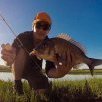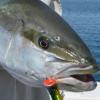
SAFTAG
-
Content Count
2 -
Joined
-
Last visited
Never
Reputation Activity
-
 SAFTAG got a reaction from Rollas in local fish tagging
SAFTAG got a reaction from Rollas in local fish tagging
Hi All. Just a couple of notes to clarify some doubts, hereabouts.1) Cod and Callop are on the approved list. However, we DO NOT encourage tagging of fish outside normal open seasons etc. If the regs suggest that Cod must not be taken, then they shouldn't be targetted. Generally Cod have a closed season to reduce stress to breeding females so they shouldn't be messed with at all. ATM we have regs that seem to be a reaction to low river levels due to an extended drought. Some thinking suggests that at these times Cod are too easy a target so rules have been put in place to protect them. Taggers are expected to follow the letter of the law as well as the spirit of the law. All the same if a tagger was trolling for Callop and hooked a small Cod we'd not get upset if he quickly placed a tag in it without removing it from the water. For information, NO COD, have been tagged by ANSA taggers since 2008.2) Tagging provides stacks of information. Apart from the obvious movements (or lack thereof) and growth rates we can also make educated guesses at how hard a fishery is fished. If, for instance, in Gulf St. Vincent 15% of tagged snapper are recaptured but in Spencer Gulf only 5% are recaptured then it would be fair to say that GSV is fished harder than SG.If over time, Mulloway recapture rates reduced from say 10% to 3% then we could make a good case for increasing bag limits.The ANSA Saftag program is a long term program. We've been tagging fish continuously since 1998. ALL the tagging programs run by Governments in SA were short term programs aimed mainly at predicting migrations etc. The Gov't has never been in a position to assess fishery health except by monitoring commercial catch rates. We hope to eventually have enough data, spread over decades, so that we can make informed scientific arguments when fish stock patterns change.3) Nanman suggested that it might not be very useful to tag fish that are already well researched. Most of the research that has been done is now out of date because fisheries have changed and research methods have changed even more. For instance, traditional thinking has Snapper migrating up the gulfs to breed in Spring and then back out to sea (where?) in Autumn. Our tag records suggest that gulf Snapper don't move much at all. Fish outside the gulfs do, however, migrate as far east as Port Philip Bay and as far west as Esperance. A case could be made that we have 4 separate populations of Snapper - 1) East 2)GSV 3) SG 4) West. Recent DNA research is making similar assumptions. Currently it would seem that although our Snapper stocks are very closely related there seems to be only random mixing of the stocks rather than annual breeding migrations. Much like Humans that were born on this side of the gulf tend to stay and breed on this side of the gulf, while only a few move or breed elsewhere we expect that only a few Snapper move out of their comfort/feeding zone.
-
 SAFTAG got a reaction from 4THALOVE in local fish tagging
SAFTAG got a reaction from 4THALOVE in local fish tagging
Hi All. Just a couple of notes to clarify some doubts, hereabouts.1) Cod and Callop are on the approved list. However, we DO NOT encourage tagging of fish outside normal open seasons etc. If the regs suggest that Cod must not be taken, then they shouldn't be targetted. Generally Cod have a closed season to reduce stress to breeding females so they shouldn't be messed with at all. ATM we have regs that seem to be a reaction to low river levels due to an extended drought. Some thinking suggests that at these times Cod are too easy a target so rules have been put in place to protect them. Taggers are expected to follow the letter of the law as well as the spirit of the law. All the same if a tagger was trolling for Callop and hooked a small Cod we'd not get upset if he quickly placed a tag in it without removing it from the water. For information, NO COD, have been tagged by ANSA taggers since 2008.2) Tagging provides stacks of information. Apart from the obvious movements (or lack thereof) and growth rates we can also make educated guesses at how hard a fishery is fished. If, for instance, in Gulf St. Vincent 15% of tagged snapper are recaptured but in Spencer Gulf only 5% are recaptured then it would be fair to say that GSV is fished harder than SG.If over time, Mulloway recapture rates reduced from say 10% to 3% then we could make a good case for increasing bag limits.The ANSA Saftag program is a long term program. We've been tagging fish continuously since 1998. ALL the tagging programs run by Governments in SA were short term programs aimed mainly at predicting migrations etc. The Gov't has never been in a position to assess fishery health except by monitoring commercial catch rates. We hope to eventually have enough data, spread over decades, so that we can make informed scientific arguments when fish stock patterns change.3) Nanman suggested that it might not be very useful to tag fish that are already well researched. Most of the research that has been done is now out of date because fisheries have changed and research methods have changed even more. For instance, traditional thinking has Snapper migrating up the gulfs to breed in Spring and then back out to sea (where?) in Autumn. Our tag records suggest that gulf Snapper don't move much at all. Fish outside the gulfs do, however, migrate as far east as Port Philip Bay and as far west as Esperance. A case could be made that we have 4 separate populations of Snapper - 1) East 2)GSV 3) SG 4) West. Recent DNA research is making similar assumptions. Currently it would seem that although our Snapper stocks are very closely related there seems to be only random mixing of the stocks rather than annual breeding migrations. Much like Humans that were born on this side of the gulf tend to stay and breed on this side of the gulf, while only a few move or breed elsewhere we expect that only a few Snapper move out of their comfort/feeding zone.
-
 SAFTAG got a reaction from bjorn2fish in local fish tagging
SAFTAG got a reaction from bjorn2fish in local fish tagging
Hi All. Just a couple of notes to clarify some doubts, hereabouts.1) Cod and Callop are on the approved list. However, we DO NOT encourage tagging of fish outside normal open seasons etc. If the regs suggest that Cod must not be taken, then they shouldn't be targetted. Generally Cod have a closed season to reduce stress to breeding females so they shouldn't be messed with at all. ATM we have regs that seem to be a reaction to low river levels due to an extended drought. Some thinking suggests that at these times Cod are too easy a target so rules have been put in place to protect them. Taggers are expected to follow the letter of the law as well as the spirit of the law. All the same if a tagger was trolling for Callop and hooked a small Cod we'd not get upset if he quickly placed a tag in it without removing it from the water. For information, NO COD, have been tagged by ANSA taggers since 2008.2) Tagging provides stacks of information. Apart from the obvious movements (or lack thereof) and growth rates we can also make educated guesses at how hard a fishery is fished. If, for instance, in Gulf St. Vincent 15% of tagged snapper are recaptured but in Spencer Gulf only 5% are recaptured then it would be fair to say that GSV is fished harder than SG.If over time, Mulloway recapture rates reduced from say 10% to 3% then we could make a good case for increasing bag limits.The ANSA Saftag program is a long term program. We've been tagging fish continuously since 1998. ALL the tagging programs run by Governments in SA were short term programs aimed mainly at predicting migrations etc. The Gov't has never been in a position to assess fishery health except by monitoring commercial catch rates. We hope to eventually have enough data, spread over decades, so that we can make informed scientific arguments when fish stock patterns change.3) Nanman suggested that it might not be very useful to tag fish that are already well researched. Most of the research that has been done is now out of date because fisheries have changed and research methods have changed even more. For instance, traditional thinking has Snapper migrating up the gulfs to breed in Spring and then back out to sea (where?) in Autumn. Our tag records suggest that gulf Snapper don't move much at all. Fish outside the gulfs do, however, migrate as far east as Port Philip Bay and as far west as Esperance. A case could be made that we have 4 separate populations of Snapper - 1) East 2)GSV 3) SG 4) West. Recent DNA research is making similar assumptions. Currently it would seem that although our Snapper stocks are very closely related there seems to be only random mixing of the stocks rather than annual breeding migrations. Much like Humans that were born on this side of the gulf tend to stay and breed on this side of the gulf, while only a few move or breed elsewhere we expect that only a few Snapper move out of their comfort/feeding zone.
-
 SAFTAG got a reaction from Boyington214 in local fish tagging
SAFTAG got a reaction from Boyington214 in local fish tagging
Hi All. Just a couple of notes to clarify some doubts, hereabouts.1) Cod and Callop are on the approved list. However, we DO NOT encourage tagging of fish outside normal open seasons etc. If the regs suggest that Cod must not be taken, then they shouldn't be targetted. Generally Cod have a closed season to reduce stress to breeding females so they shouldn't be messed with at all. ATM we have regs that seem to be a reaction to low river levels due to an extended drought. Some thinking suggests that at these times Cod are too easy a target so rules have been put in place to protect them. Taggers are expected to follow the letter of the law as well as the spirit of the law. All the same if a tagger was trolling for Callop and hooked a small Cod we'd not get upset if he quickly placed a tag in it without removing it from the water. For information, NO COD, have been tagged by ANSA taggers since 2008.2) Tagging provides stacks of information. Apart from the obvious movements (or lack thereof) and growth rates we can also make educated guesses at how hard a fishery is fished. If, for instance, in Gulf St. Vincent 15% of tagged snapper are recaptured but in Spencer Gulf only 5% are recaptured then it would be fair to say that GSV is fished harder than SG.If over time, Mulloway recapture rates reduced from say 10% to 3% then we could make a good case for increasing bag limits.The ANSA Saftag program is a long term program. We've been tagging fish continuously since 1998. ALL the tagging programs run by Governments in SA were short term programs aimed mainly at predicting migrations etc. The Gov't has never been in a position to assess fishery health except by monitoring commercial catch rates. We hope to eventually have enough data, spread over decades, so that we can make informed scientific arguments when fish stock patterns change.3) Nanman suggested that it might not be very useful to tag fish that are already well researched. Most of the research that has been done is now out of date because fisheries have changed and research methods have changed even more. For instance, traditional thinking has Snapper migrating up the gulfs to breed in Spring and then back out to sea (where?) in Autumn. Our tag records suggest that gulf Snapper don't move much at all. Fish outside the gulfs do, however, migrate as far east as Port Philip Bay and as far west as Esperance. A case could be made that we have 4 separate populations of Snapper - 1) East 2)GSV 3) SG 4) West. Recent DNA research is making similar assumptions. Currently it would seem that although our Snapper stocks are very closely related there seems to be only random mixing of the stocks rather than annual breeding migrations. Much like Humans that were born on this side of the gulf tend to stay and breed on this side of the gulf, while only a few move or breed elsewhere we expect that only a few Snapper move out of their comfort/feeding zone.
-
 SAFTAG got a reaction from mrballs in local fish tagging
SAFTAG got a reaction from mrballs in local fish tagging
Hi All. Just a couple of notes to clarify some doubts, hereabouts.1) Cod and Callop are on the approved list. However, we DO NOT encourage tagging of fish outside normal open seasons etc. If the regs suggest that Cod must not be taken, then they shouldn't be targetted. Generally Cod have a closed season to reduce stress to breeding females so they shouldn't be messed with at all. ATM we have regs that seem to be a reaction to low river levels due to an extended drought. Some thinking suggests that at these times Cod are too easy a target so rules have been put in place to protect them. Taggers are expected to follow the letter of the law as well as the spirit of the law. All the same if a tagger was trolling for Callop and hooked a small Cod we'd not get upset if he quickly placed a tag in it without removing it from the water. For information, NO COD, have been tagged by ANSA taggers since 2008.2) Tagging provides stacks of information. Apart from the obvious movements (or lack thereof) and growth rates we can also make educated guesses at how hard a fishery is fished. If, for instance, in Gulf St. Vincent 15% of tagged snapper are recaptured but in Spencer Gulf only 5% are recaptured then it would be fair to say that GSV is fished harder than SG.If over time, Mulloway recapture rates reduced from say 10% to 3% then we could make a good case for increasing bag limits.The ANSA Saftag program is a long term program. We've been tagging fish continuously since 1998. ALL the tagging programs run by Governments in SA were short term programs aimed mainly at predicting migrations etc. The Gov't has never been in a position to assess fishery health except by monitoring commercial catch rates. We hope to eventually have enough data, spread over decades, so that we can make informed scientific arguments when fish stock patterns change.3) Nanman suggested that it might not be very useful to tag fish that are already well researched. Most of the research that has been done is now out of date because fisheries have changed and research methods have changed even more. For instance, traditional thinking has Snapper migrating up the gulfs to breed in Spring and then back out to sea (where?) in Autumn. Our tag records suggest that gulf Snapper don't move much at all. Fish outside the gulfs do, however, migrate as far east as Port Philip Bay and as far west as Esperance. A case could be made that we have 4 separate populations of Snapper - 1) East 2)GSV 3) SG 4) West. Recent DNA research is making similar assumptions. Currently it would seem that although our Snapper stocks are very closely related there seems to be only random mixing of the stocks rather than annual breeding migrations. Much like Humans that were born on this side of the gulf tend to stay and breed on this side of the gulf, while only a few move or breed elsewhere we expect that only a few Snapper move out of their comfort/feeding zone.




